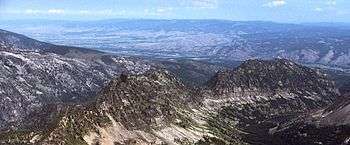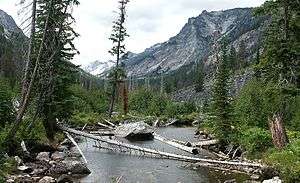Bitterroot Valley
Coordinates: 46°14′49″N 114°09′36″W / 46.247°N 114.160°W

The Bitterroot Valley is located in southwestern Montana, along the Bitterroot River between the Bitterroot Range and Sapphire Mountains, in the Northwestern United States.
Geography
The valley extends approximately 95 miles (160 km) from Lost Trail Pass in Idaho, where it is narrow, to a point near the city of Missoula along I-90 where it is wider and flatter. To the west is the Bitterroot Range and its large Selway-Bitterroot Wilderness Area, and to the east is the smaller Sapphire Mountains and their Anaconda-Pintler Wilderness Area. The Bitterroot Range has steep faces, deep canyons, is heavily forested, and is within the Bitterroot National Forest. The Sapphire Mountains are more rounded, drier, and much less forested.[1]
The southern end of the valley is split into the East and West Forks of the Bitterroot River, and the northern end has the confluence of the Bitterroot River with the Clark Fork River, the largest river in Montana. Connecting into the west side of the valley are numerous deeply carved granite canyons, including scenic Blodgett Canyon and Lolo Creek's canyon.
Highway 93 runs through the center of the valley, exiting to the south over 7014 foot (2140 m) Lost Trail Pass. U.S. Highway 93 is the main travel choice through the Bitterroot Valley but East Side Highway also runs through the valley, being much less traveled.
Communities
Communities within the valley include: Lolo in Missoula County; and Florence, Stevensville, Victor, Corvallis, Hamilton, Darby, Conner, and Sula in Ravalli County.
Hamilton, the largest town and the county seat of Ravalli County, is located at 46°14.8'N and 114°09.6'W at an elevation of 3570 ft (1090 m) with a population of 4,000. Business opportunities within these cities include manufacturing, agriculture, craft breweries, wineries, recreational services, and many entrepreneurs.[2]
History
The valley was the ancestral home of the Salish tribe of the Flathead nation.
In early September 1805, the Lewis and Clark Expedition crossed Lost Trail Pass from present-day Idaho in order to connect with the overland route through the Rocky Mountains. Passing down Camp Creek and the East Fork, they followed the Bitterroot River northward to the point where it connects with the Nez Perce Trail and Lolo Creek. Before continuing their difficult journey to the west, they named their camp Traveler's Rest. Returning to this site in early July of the following year, they split their Corps of Discovery, furthering their explorations both to the northeast (Lewis) and to the south (Clark).[3]
The first 'white' settlement in the valley was the founding in 1841 of St. Mary's Mission, near present-day Stevensville, by Father DeSmet. Fort Owen was established nearby in 1850, and difficult relations occurred between the white settlers and the Salish until 1891, when the native tribes were relocated to the north. In 1877 Chief Joseph and the Nez Perce tribe passed south through the Bitterroot Valley, fleeing the U.S. Army. They exited the East Fork via Gibbons Pass, near where they fought at the Battle of the Big Hole.
Settlement has continued since that time. The population of Ravalli County in the 2000 census was 36,070; 40,212 in the 2010 census.[4] The major industries are ranching, agriculture, forestry, and tourism.

Recreation
The Bitterroot Valley offers many recreational activities, including: hiking, backpacking, mountain biking, and rock climbing in the surrounding mountains; and birding and fishing along the Bitterroot River. The valley is popular with hunters, for big game, upland birds, and waterfowl.[5]
See also
References
- ↑ Go Northwest, LLC. Bitterroot Valley. Northwest Montana Travel Region. (1997-2014). 23 July 2014 Archived August 4, 2014, at the Wayback Machine.
- ↑ Distinctly Montana. "The Beautiful Bitterroot Valley." Wildlife & Parks. (2011). 24 July 2014
- ↑ Historic St. Mary's Mission, Inc. "Bitter Root Salish History." Historic St. Mary's Mission & Museum. (2004-2014). 23 July 2014
- ↑ http://www.zip-codes.com/county/MT-RAVALLI-2010-census.asp
- ↑ K Design Marketing Inc. "History of the Bitterroot Valley." Bitterroot Valley Chamber of Commerce. (2014). 24 July 2014
External links
- A virtual aerial image, looking northwest across all of the Bitterroot Range and the Bitterroot Valley, can be viewed at this external link.
- Bitterroot Valley Chamber of Commerce